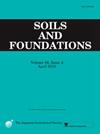Effect of deep mixed column pattern on the performance of basal reinforced embankment resting on soft soil
IF 3.3
2区 工程技术
Q2 ENGINEERING, GEOLOGICAL
引用次数: 0
Abstract
The deep mixing method (DMM) a soil solidification technique, involves mechanically blending the natural soft soil with a binder to create stiffer soil columns or panel walls, enhancing stability in soft ground areas. In this study, different configurations of deep mixed (DM) columns with a consistent area ratio were tested under vertical loading. Various column patterns, including Square Group Columns (SGC), Longitudinal Tangent Wall (LTW), Transverse Tangent Wall (TTW), and Tangent Grid (TG), were evaluated for their response to stress-settlement, the heaving of the soft clay, and the lateral deformation of the embankment slope. Particle Image Velocimetry (PIV) was employed to analyse ground deformation during the tests. The results show that the LTW pattern has the least, while the TG pattern has the maximum heaving of soft soil and lateral deformation of the embankment slope. The LTW pattern showed the most significant strength improvement, while the TG pattern demonstrated the least enhancement in strength compared to the other patterns. A post-examination of the deformed column was conducted to understand the column failure pattern, and it was noted that the DM column primarily experienced failure due to tilting and bending, indicating that these columns did not fully mobilize their shear strength.
深层混合柱模式对软土基础加筋路堤性能的影响
深层混合法(DMM)是一种土壤固化技术,它将天然软土与粘合剂机械混合,形成更硬的土柱或板墙,提高软土地区的稳定性。在竖向荷载作用下,对具有相同面积比的不同配置深度混合柱进行了试验研究。对方柱群(SGC)、纵向切线墙(LTW)、横向切线墙(TTW)和切线网格(TG)等不同柱型对应力沉降、软土隆起和路堤边坡侧向变形的响应进行了评价。采用粒子图像测速法(PIV)对试验过程中的地面变形进行了分析。结果表明:LTW模式对软土的隆起和路堤边坡的侧向变形影响最小,而TG模式对路堤边坡的侧向变形影响最大;与其他模式相比,LTW模式的强度提高最为显著,而TG模式的强度提高最少。对变形柱进行了事后检查,以了解柱的破坏模式,并指出DM柱主要是由于倾斜和弯曲而发生破坏,这表明这些柱没有充分发挥其抗剪强度。
本文章由计算机程序翻译,如有差异,请以英文原文为准。
求助全文
约1分钟内获得全文
求助全文
来源期刊

Soils and Foundations
工程技术-地球科学综合
CiteScore
6.40
自引率
8.10%
发文量
99
审稿时长
5 months
期刊介绍:
Soils and Foundations is one of the leading journals in the field of soil mechanics and geotechnical engineering. It is the official journal of the Japanese Geotechnical Society (JGS)., The journal publishes a variety of original research paper, technical reports, technical notes, as well as the state-of-the-art reports upon invitation by the Editor, in the fields of soil and rock mechanics, geotechnical engineering, and environmental geotechnics. Since the publication of Volume 1, No.1 issue in June 1960, Soils and Foundations will celebrate the 60th anniversary in the year of 2020.
Soils and Foundations welcomes theoretical as well as practical work associated with the aforementioned field(s). Case studies that describe the original and interdisciplinary work applicable to geotechnical engineering are particularly encouraged. Discussions to each of the published articles are also welcomed in order to provide an avenue in which opinions of peers may be fed back or exchanged. In providing latest expertise on a specific topic, one issue out of six per year on average was allocated to include selected papers from the International Symposia which were held in Japan as well as overseas.
 求助内容:
求助内容: 应助结果提醒方式:
应助结果提醒方式:


